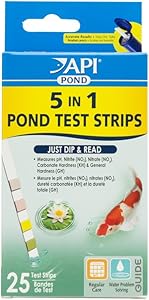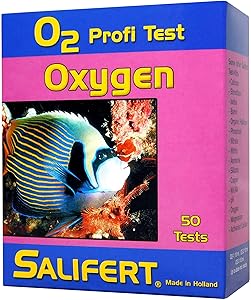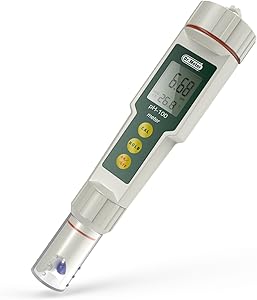Everyone loves a water garden full of beautiful plants and goldfish.
Koi enthusiasts enjoy the bright colors and personalities of their fish. Ponds allow us to have a piece of nature in our own backyard.
But man-made ponds are not really “natural.” They can’t stay beautiful and healthy without our help.
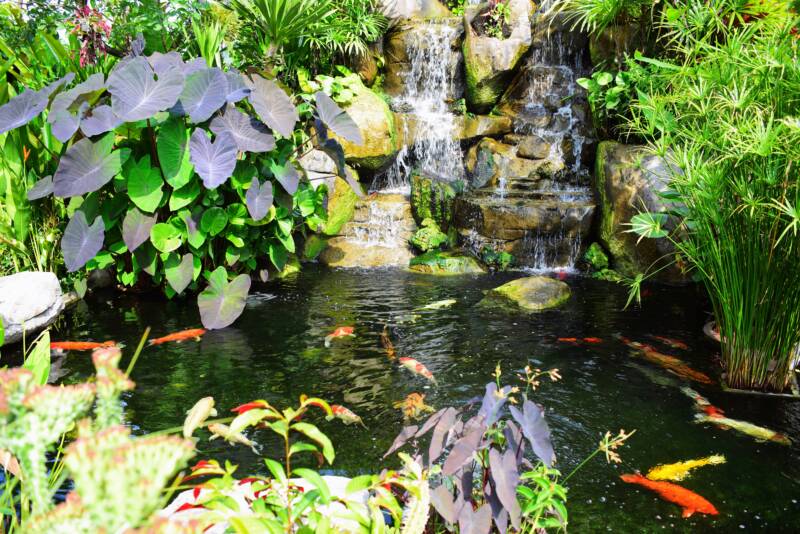
Let’s face it, you wouldn’t have a pond in your backyard unless you dug the hole, put in a plastic liner, and filled it with water. There’s seasonal maintenance, like preparing for winter, spring clean-outs, and repotting water lilies.
Water quality isn’t on the minds of most pond enthusiasts until something goes wrong. That’s why testing is so important!
Water testing allows you to make sure the water is safe for the fish and isn’t degrading over time.
There is no way to gauge water conditions by looking at the water. Water testing has saved many pond-keepers from heartache.
You don’t have to be a chemist to monitor your pond’s water quality. Many high-quality pond water test kits are easy and fun to use. We’ll review the best test kits for water gardeners and koi keepers.
But first, it’s important to know what to test for and why.
[toc]
Why you should test your pond water

Goldfish and koi consume natural foods, like worms and insects, along with prepared pellet and stick foods.
The fish digest the protein in the food. Ammonia is a byproduct of the fish’s metabolism. It’s released into the water primarily through the fish’s gills. Solid waste and uneaten foods decompose, adding ammonia to the water.
Ammonia is toxic to pond fish. Nitrifying bacteria (biological filtration) convert ammonia to nitrite (also toxic) then to relatively harmless nitrate.
It takes time for the bacteria to become active when a pond is first filled with water. Therefore, it is essential to monitor ammonia and nitrite during the first four to six weeks after fish are added.
Eventually, the pond’s biological balance will stabilize, bringing ammonia and nitrite to undetectable levels. Testing alerts you if you need to make a water change or cut back on feeding while the new pond matures.
pH is another important test parameter. The biological conversion of ammonia to nitrate produces acids. The acids can deplete the pond of pH-stabilizing carbonates, causing the water to become acidic.
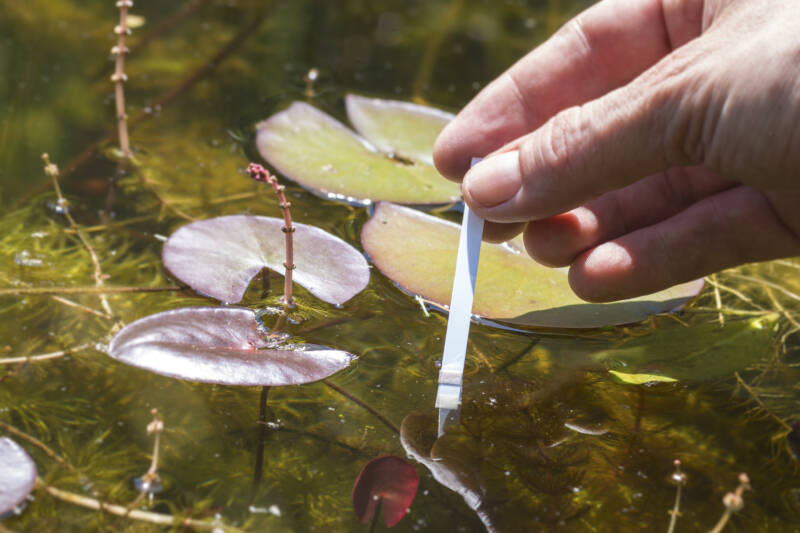
A sudden drop in pH tends to inhibit the biological filter, causing a build-up of ammonia. You can see how pH, alkalinity, and biological activity in the pond affect one another.
But what about an established fish pond or water garden? They benefit from water testing too.
Should I test an established pond?
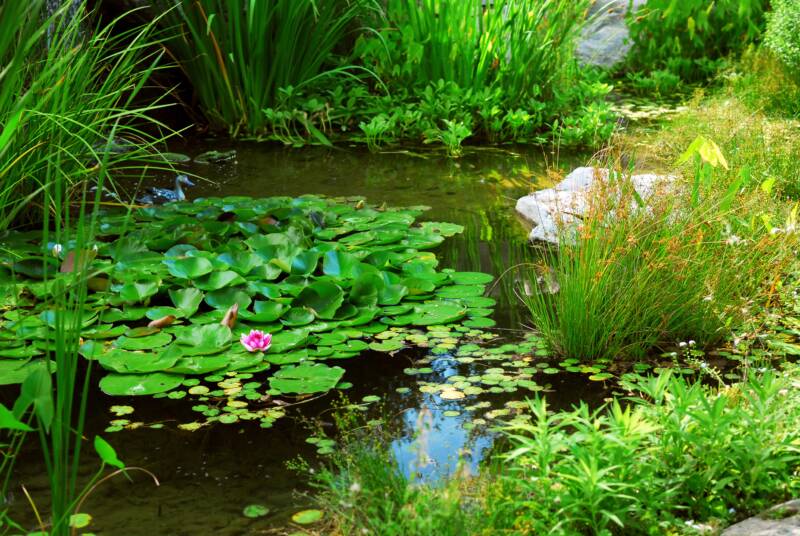
If your pond has passed the one-year mark, it has developed a nice microbe community. This invisible group of bacteria, worms, fungi, and plankton keeps the pond healthy and capable of supporting aquatic life.
When things are going well in the pond, water testing will confirm it. That can bring peace of mind, knowing that you’re doing things right. But testing can also alert you when something is out of balance.
Detectable levels of ammonia or nitrite signal a fish is decaying in the pond or too much food is being added.
It can also mean your fish have outgrown the capacity of the pond. Some water supplies are naturally low in carbonates, meaning the pond’s pH will drop over time.
Testing the pH and alkalinity monthly will reveal any tendency for the pH to fall into the acidic range.
Monitoring algae-promoting nutrients

Algae, both stringy filamentous types and planktonic green water, need the same nutrients as water lilies and other pond plants.
When the nutrient level in the water reaches the tipping point, algae will respond by multiplying.
Water gardeners rely on aquatic plants to remove excess nutrients from the water and keep the algae in starvation mode. In many cases, plants will prevent algae problems.
Koi ponds normally don’t contain plants, so nutrient control is more difficult.
Some pond-keepers keep an eye on nitrate and phosphate levels, especially if they have an algae problem that won’t clear up. Water changes are made to keep nutrients low.
Oxygen is important
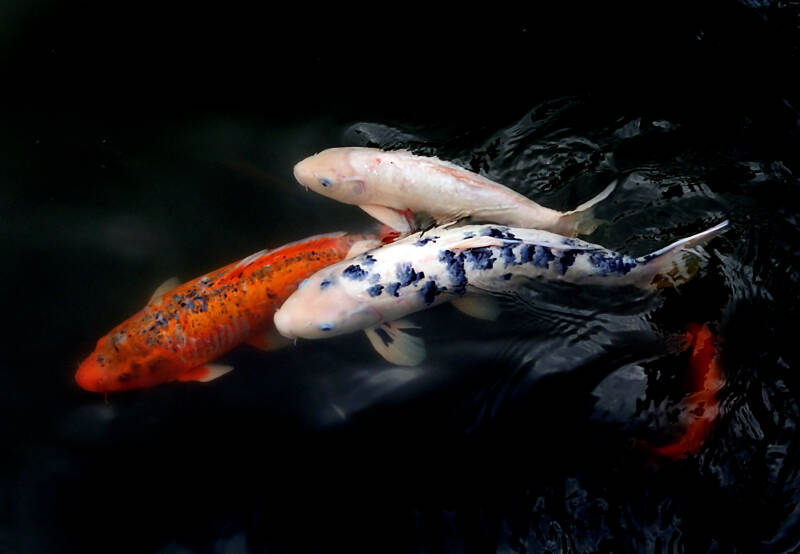
Koi and goldfish absorb oxygen from the pond water. Oxygen naturally diffuses into the water from the atmosphere.
But in most ponds, natural diffusion isn’t enough. That’s because many of the invisible biological and chemical processes operating inside the pond use more oxygen than the water can absorb.
Pond aerators, waterfalls, and fountains disturb the water surface, increasing the oxygen diffusion.

It’s also important to understand that as pond water temperature increases, the ability to hold oxygen declines.
If you’ve got a pond full of koi, it’s especially important to aerate the water during the hot summer months.
Koi enthusiasts find oxygen testing a valuable tool for safeguarding their fish collection.
Oxygen should be tested in the early morning before algae and plants begin producing oxygen. This will provide a baseline oxygen level to gauge the efficiency of the pond’s aeration.
Ideal pond water parameters
pH
pH levels rise in the morning as plants and algae remove carbon dioxide from the water. The pH could increase to 9, then fall back to 7.0 in the evening. This is the natural pH cycle.
The best time to test is in the early morning. Look for the pH to be 7.0 or above. If the morning pH is less than 7.0 and the pond is being aerated, consider making a water change to increase carbonates or using a pH-increaser water treatment.
Carbonate hardness
Carbonate hardness (KH) is the measure of carbonates in the water. Carbonates stabilize pH and prevent it from dropping too low.
When the KH level is below 40 ppm, the pH could start to drift below 6.5. Make a water change or add a pH adjuster containing carbonates to restore the KH level to 50 ppm or higher.
General hardness
Also known as “GH”, general hardness is simply the level of calcium and magnesium (water hardness) in the water. GH is not harmful, and there is no perfect range.
Plants use calcium and magnesium. These minerals are found in tap water and will also enter the pond from soil run-off and soil used in potted pond plants.
Ammonia
Ammonia should always be zero ppm (parts per million).
During the first 4-6 weeks of start-up, ammonia levels can rise to 1.0 ppm or higher. Reduce feeding for several weeks until the ammonia drops to zero.
Nitrite
Nitrite is very toxic to pond fish.
If the level rises above 25 ppm, reduce feeding, and monitor the level. Adding pond salt is recommended since it blocks the toxicity of nitrite.
Nitrate
In a water garden, nitrate will usually be zero because plants are using it as a nutrient.
Koi ponds with heavy fish loads are likely to see nitrate levels over 100 ppm. Fish sensitivity to nitrate is species-specific, and the jury is still out on long-term effects.
Ideally, nitrate should be 20 ppm or below.
Phosphate
Phosphate is a concern only if there is an ongoing algae problem. There is no ideal phosphate level. Lower is considered better.
Water gardens usually have zero phosphates, but koi ponds can have levels as high as 50 ppm.
Oxygen
The oxygen-holding property of water is temperature-dependent. The warmer the water, the less oxygen it can contain. Most water gardeners don’t need to test for oxygen.
Aeration is crucial in heavily stocked koi ponds. Ideally, the oxygen level is maintained at 8-9 ppm.
Testing on very warm days and nights will show how well the aerator or waterfall maintains oxygen levels.
How often should I test my pond?

There are no set rules on water testing. But experience shows that there are certain guidelines that work in most situations.
When first setting up a pond or when the water warms to about 50°F (10°C) in springtime, test the water once a week for four weeks. New ponds or ponds “waking up” from winter will go through a break-in period where the microbes respond to ammonia from fish waste, food, and decayed plant matter that collected over the winter.
After the first month, test monthly unless a water quality problem arises.
pH, ammonia, and nitrite are especially important test factors. Carbonate hardness affects pH and is key to understanding why pH is dropping. Test KH along with pH each month.
Phosphate and oxygen are optional tests for diagnosing problems, but there’s no harm in testing and learning about trends in the pond.
Top Rated Pond test kits
1. API 5 In 1 Pond Test Strips
The API dip strips are fast and easy. Each strip contains tests for pH, KH, GH nitrite, and nitrate.
Dip the strip in the water and compare the results to the color chart.
Dip strips are sensitive to humidity. API has packaged the dip strips in a sturdy plastic tube that keeps them safe and dry. The kit contains 25 test strips. Ammonia test strips are not included in the API 5 In 1 Pond Test.
2. API Pond Master Test Kit
The Pond Master Test Kit is based around traditional liquid test chemicals and test tubes.
The kits work by taking a water sample in the test tube, adding drops of test chemicals, and shaking the capped tube. You then match the color in the test tube to a corresponding color chart.
The Pond Master Test Kit contains tests for ammonia, nitrite, pH, and phosphate. You’ll be able to make over 500 tests with this pond test kit.
A helpful booklet is included that explains how to perform each test and what the results mean.
3. Nutrafin Carbonate and General Hardness Test Kit
This test kit only measures general hardness (GH) and carbonate hardness (KH).
The KH test will be helpful for monitoring the carbonate level, which you can link to pH with another test kit. GH is not a health or maintenance concern but is an interesting parameter to track over the months.
This kit uses liquid test chemicals and a glass test tube.
4. Salifert Dissolved Oxygen Test Kit
Oxygen testing can be complicated and expensive, but the Salifert Dissolved Oxygen Test makes it easy and affordable.
The simple liquid test kit will tell you how much oxygen is in your pond water. It’s a good way to confirm that the water is well-oxygenated during hot weather.
5. Dr. Meter PH100 Pocket Size pH Meter with ATC
pH meters are electronic instruments that measure the pH and display the values on an LCD screen.
pH meters take the human factor out of matching color in a test tube to a color chart. The pH meter is able to measure and report the pH more accurately than dip strip and liquid test kits.
But you’ll have to calibrate the meter with standard pH solutions every time you use the meter if you want accurate measurements.
Recommendations
All the test kits reviewed are capable of providing water quality information.
The pH meter is more accurate but time-consuming to calibrate, clean, and properly store.
For most water gardeners and koi enthusiasts, test kits provide plenty of accuracy for monitoring water quality.
My favorite is the API Pond Master Test Kit. It’s a great value at over 500 tests, plus it provides ammonia, nitrite, pH, and phosphate testing all in one kit. These are the most-used test parameters by the majority of pond-keepers.
The API 5 In 1 Pond Test Strips are quick and easy but lack an ammonia test. But you can buy the aquarium version of the API ammonia dip strip, making a complete test kit on your own.
If you’re curious about oxygen levels, the Salifert test is economical and easy to use.
Please leave comments and questions below!

